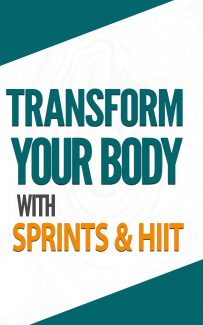 License Type: Master Resell Rights
License Type: Master Resell Rights  File Type: ZIP
File Type: ZIP
 SKU: 63518
SKU: 63518  Shipping: Online Download
Shipping: Online Download
Sample Content Preview
Introduction
Have you ever noticed how the physiques of world class sprinters and athletes involved in similar disciplines are looking for muscular, ripped, and defined than ever? Their bodies resemble those of Greek Gods, which is surely a testament to the sporting disciplines that they are involved in.
If you’re looking to tone up, trim down, and increase your lean muscle mass, HIIT is one of the most effective forms of physical exercise currently in existence. HIIT is not only beneficial for transforming your physique, it is also ideal for people looking to improve their health and fitness in general.
But what exactly is HIIT and sprint training, why are they now so hugely popular, what benefits do they offer over conventional cardio and resistance-based exercise, and is there anything special you need to know?
All of these questions will be addressed in this useful guide to HIIT, so if you’re ready to start transforming your body, here is you’re an introduction to Sprints & HIIT.
Chapter 1 – What The Heck Is HIIT?
To start things off, we’re going to bring you up to speed with what HIIT actually is.
HIIT stands for High Intensity Interval Training and it is a relatively new form of physical exercise that is taking the fitness industry by storm.
How the exercise is actually performed is explained in the name. To make a long story short, HIIT involves people alternating between periods of fast-paced, high intensity exercise and slow-paced, low-intensity exercise.
As a very simple example, one form of HIIT may require an individual to get onto a treadmill and begin by walking at a slow speed for 30 seconds. This is the low-intensity form of the exercise.
Next, after those 30 seconds are up, they may then crank up the speed and sprint at around 95% of their max capacity for 30 seconds. They will run as fast as they can, and this is the high-intensity portion of the exercise.
After those 30 seconds are up, that will be one round completed. They will then drop the speed down so that they walk again, and will repeat the process for several more rounds.
A typical HIIT workout will last between 20 and 30 minutes. The thing to remember is that, in order for HIIT to work, you really do need to be pushing yourself as hard as you can during the high-intensity portion of the exercise.
By the end of it, your heart rate should be up, you should be sweating, and in all honesty, you should feel a little sick, and you may struggle to talk.
HIIT is great because it is all relative to how fit each individual is. It can be adapted, so if you are a beginner, you could increase the amount of time spent on the low-intensity portion of the exercise. So, you could opt for 60 seconds of “rest” and 30 seconds of sprints. As you get fitter, simply reduce the amount of time spent recovering. You may also increase the amount of time spent sprinting.
Chapter 2 – What Is The Optimal Training Zone?
As mentioned, it is all relative based upon overall fitness levels, but generally speaking, in order for HIIT to work, you need to be pushing yourself incredibly hard on the high-intensity portion of the exercise.
How hard? Well, many health experts and personal trainers recommend anything from 85% - 100% of your maximum heart rate during the high intensity portions of the exercise.
That’s right, in order for the workout to be effective you really do need to be working hard. It’s no good just jogging leisurely, or perhaps running a little faster than you do when you perform steady state cardio, because that will not work.
To achieve maximum fat burning results you need to be sprinting, and you need to be sprinting as fast as you can.
Imagine yourself racing against Usain Bolt, trying to set a new World Record, or being chased by a hungry and angry bear like the one that messed Leo DiCaprio up so much in The Revenant
Chapter 3 – How Often Should HIIT Be Performed
As you might expect, answers to this question will vary depending on whom you speak to.
Some people for example, may recommend that you perform HIIT five times per week, while others may tell you that twice per week is sufficient enough.
The general consensus however, and this is based off of science and numerous studies and hours upon hours of extensive research, have concluded that HIIT workouts should be performed no more than three times per week, when used in conjunction with other forms of exercise.








